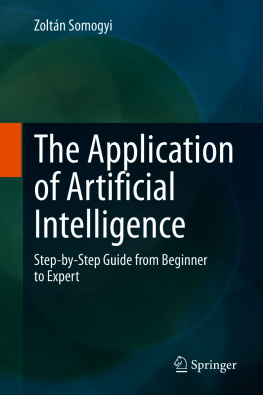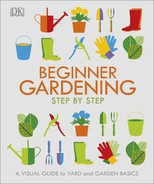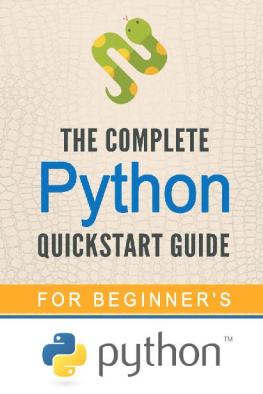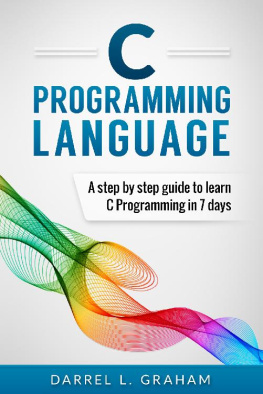PYTHON PROGRAMMING
A Step By Step Guide from Beginner to Advanced
(Beginner & Advanced)
By
Anthony Aline
Table of Contents
Introduction
Note that, the beginning in coding can be annoying. It is possible to have seen a couple of the most familiar coding languages, such as Java or C++. Several people are scared of programming and are of the opinion that it was illogically difficult for them. In either case, using Python programming language, will help you discover that it is simpler than ever in recent time to know more about coding and to make attempts in analyzing it like an expert.
This gradual help is going to provide you a part of the rudimentary that you have to begin with python programming. We will commence with explaining what Python programming entails and also some of the stages that you should adhere to in order to understand the program. We will at that point move forward to certain code words that will be precious to you when parting with the program and also discussion about the pros and cons of making use of Python for every of your coding and programming demand.
Things that you can perform inside the Python program just as flawless sample of the way each of these would work. We speak concerning the inclusion of comments into the code, make do with strings and integers, and also dedicate some power collaborating with variables so they will come out good in the program. It is a great plan to put to trial a bit with the method. Python ensures that it is easy to try out your strings with the aim that you can deduce whats useful for business and what requires more attention.
The start in programming can seem to be difficult. You may be disturbed that you arent going to have the alternative to make meaning of all and those stupid programming languages may have terrified you from it in any case. This book will put to application some energy discerning the Python language and finding out how easy it is, to start with, this fundamental but important program.
Chapter-1:
Details Of Python Programming?
In this section, there will be discovery about the history of Python, what it is mainly used for, its advantages, and what makes it higher ranking to other languages
History:
During the late 80s, a Dutch programmer Guido van Rossum at CWI (Centrum Wiskunde & Informatica) intellectualize Python programming. Its application started in December 1989 in the Christmas week for fun. The initial version of this program first officially showed in 1991(0.09 version). So, how about its name Python: majority of people give thoughts about snakes, and even the symbol shows two snakes, but its birth was coincidentally named after the popular British sketch comedy series Monty Pythons Flying Circus as the establishing father was a big admirer. In the course of the next year, the language was welcomed by the group of the Amoeba project ( Amoeba is a scattered operating system designed by Andrew S. and their group in Holland Amsterdam at the Vrije Universiteit. Amoeba projects major tool was to develop a time-sharing design that makes a total network of computers seem to the operator as a single machine. This development stopped here at 5.3 version, on 07/30/1996. It was the platform where the Python programming language firstly evolved while Guido went after its improvement majorly in his leisure
Recently it has turned out to be one of the most intriguing programming languages of our time. This deviant program showed like an easy pastime quoting; by Guido van Rossum. In a TV conference, Guido van Rossum said: In the early 1980s, I toiled as a facilitator on a group developing a language called ABC at (CWI). I made an attempt to reference ABCs influence due to the fact that Im committed to the total thing I learned during that development and to those who toiled on it
Subsequently in the same conference, Guido van Rossum stated: I look back on all adventure and some of my hindrance with ABC. I was clear to attempt to develop an easy scripting language that preoccupy part of ABCs better properties but disadvantaged of its challenges. So I started composing. I designed an easy effective device, parser and runtime. I created my kind of the number of ABC portions that I desired. I made a fundamental syntax, used a gouge for statement teaming instead of wavy braces or begin-end blocks and created a little number of strong data varieties: a hash table (or dictionary, as it is called), a list, numbers and strings.
Like other languages, Python, has evolved through various versions. Python 0.9.0 was initially announced in 1991(as stated before) along with exclusion handling, Python involved strings, lists and classes. Most importantly, it comprises of filter, lambda, map and reduce, which lined it up critically regarding practical programming
Earlier in 2000, 2.0 version of Python was produced. This version was majorly of a free source project from participants of the National Research Institute of Mathematics and Computer Science. This particular version of Python comprises of full trash amassed, it reinforced Unicode and list comprehensions
The 3.0 version was produced in Dec 2008. As much as Python 2 and 3 are alike, there underrated distinction. Probably most extremely is the method the print statement functions, as in Python 3.0 the print statement has been changed with a print () function. It is necessary you download and install the newest version of Python. The most recent ( as of winter 2019) is Python 3.7.2
Syntax Quick Guide
The design in which words and sentences are arranged to develop sentences is known as syntax. A parser reads a Python program. Python was created to be an extremely readable language. The syntax of the Python programming language is the array of order which shows the way to write in Python Programming language.
Similarly, to normal languages, a computer programming language comprises a set of pre-established words which are named code words. A predetermined rule of usage for every code word is called syntax.
Python 3.x interpreter has 33 keywords explained in it. Since they have a predetermined definition attached, it cannot be used for any other reason. The list of Python code words can be gotten by making use of the below help command in Python shell.
Syntax discuss about the design of the language (i.e., what begins a correctly- made program). For now, we will not focus on the meanings- the definition of the symbols and words within the syntax but will go back to this eventually.
See the following code example:
lower: [0, 1, 2, 3, 4]
upper: [5, 6, 7, 8, 9]
This given script looks a little bit cautious, although it competently shows lots of the important aspects of Python syntax. Lets go through it and explain some of the syntactical characteristics of Python
Comments mark by sign, #
The content starts with a clarification:
Comments in Python are stated by a pound sign (#) and the translator miss whatsoever thing on the line after the pound sign. For instance, it is possible to have separated comments like the one just shown, plus inline comments that is after a statement.
For instance:
Python has no syntax for multi-line comments, like /*. The */ language applied in C++ and C, though they are multi-line strings, you can use them instead of multi-line comments. More will be shown on this in string Manipulation









